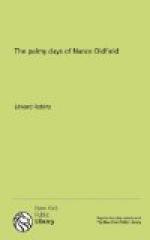In a succeeding paragraph the reader finds that a cherished nineteenth-century custom—the representing of a vast army by the employment of half-a-dozen ill-fed, unpainted supers—has at least the sanction of age: “Another mechanical method of making great men, and adding dignity to kings and queens, is to accompany them with halberts and battle-axes. Two or three shifters of scenes, with the two candle-snuffers, make up a complete body of guards upon the English stage; and by the addition of a few porters dressed in red coats, can represent above a dozen legions. I have sometimes seen a couple of armies drawn up together upon the stage, when the poet has been disposed to do honour to his generals. It is impossible for the reader’s imagination to multiply twenty men into such prodigious multitudes, or to fancy that two or three hundred thousand soldiers are fighting in a room of forty or fifty yards in compass. Incidents of such a nature should be told, not represented.”
Addison remarks that “the tailor and painter often contribute to the success of a tragedy more than the poet,” a trite saying which holds good now, and he ends his essay with the belief that “a good poet will give the reader a more lively idea of an army or a battle in a description, than if he actually saw them drawn up in squadrons and battalions, or engaged in the confusion of a fight. Our minds should be open to great conceptions, and inflamed with glorious sentiments by what the actor speaks, more than by what he appears. Can all the trappings or equipage of a king or hero give Brutus half the pomp and majesty which he receives from a few lines in Shakespeare?” Which is all very true, yet “the tailor and painter” will continue popular, no doubt, until the crack of doom.
The month of December 1714 saw the reopening of the theatre in Lincoln’s Inn Fields, under letters patent originally granted by Charles II. to Christopher Rich, and restored by his broken-English Majesty George I. The renewal created a dangerous rival to Drury Lane, but it is not probable that the king worried over having planted such a thorn in the sides of Messrs. Steele, Booth, Wilks, and Cibber[A]. He remembered, he told Mr. Craggs, “when he had been in England before, in King Charles his time, there had been two theatres in London; and as the patent seemed to be a lawful grant, he saw no reason why two playhouses might not be continued.”
[Footnote A: On the death of Queen Anne the old licence or patent of Drury Lane lapsed, and when the new one was issued Steele was named therein as a partner.] Several useful players left Drury Lane to go over into Lincoln’s Inn Fields,[A] chief among them being Mrs. Rogers, who felt greatly relieved in transferring her affectations of virtue to a house where she would no longer be overshadowed by the genius of Oldfield. As for Nance, she was faithful to the old theatre, and continued to be the fairest though perhaps the frailest of its pillars, notwithstanding the personal




